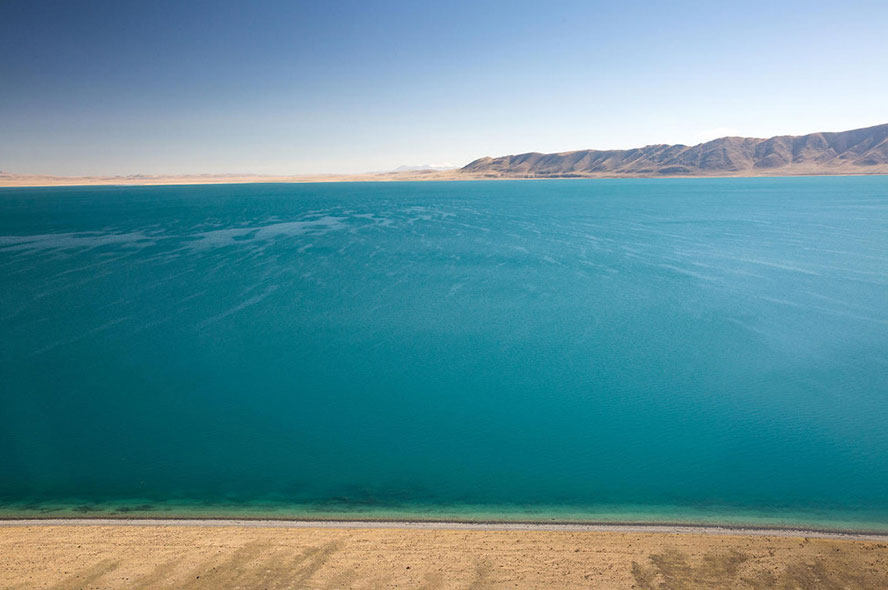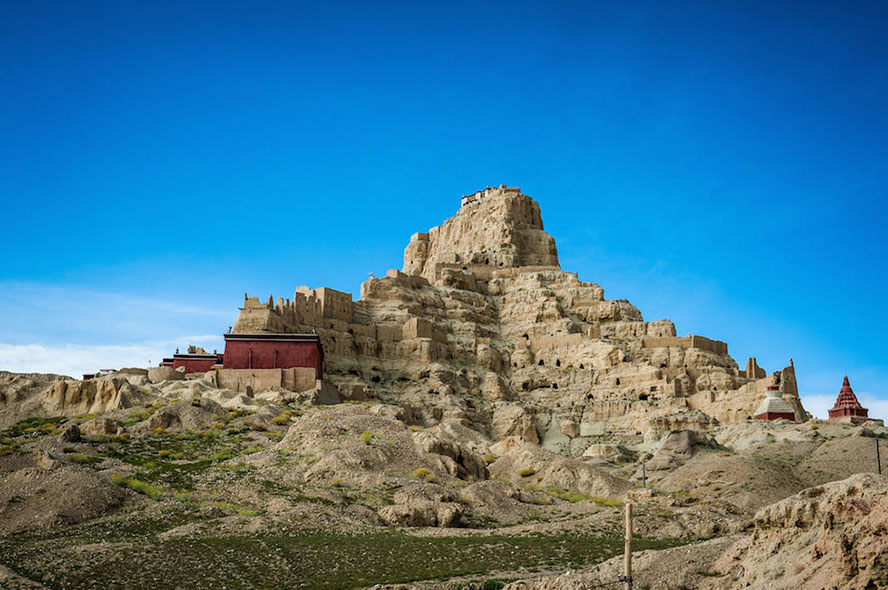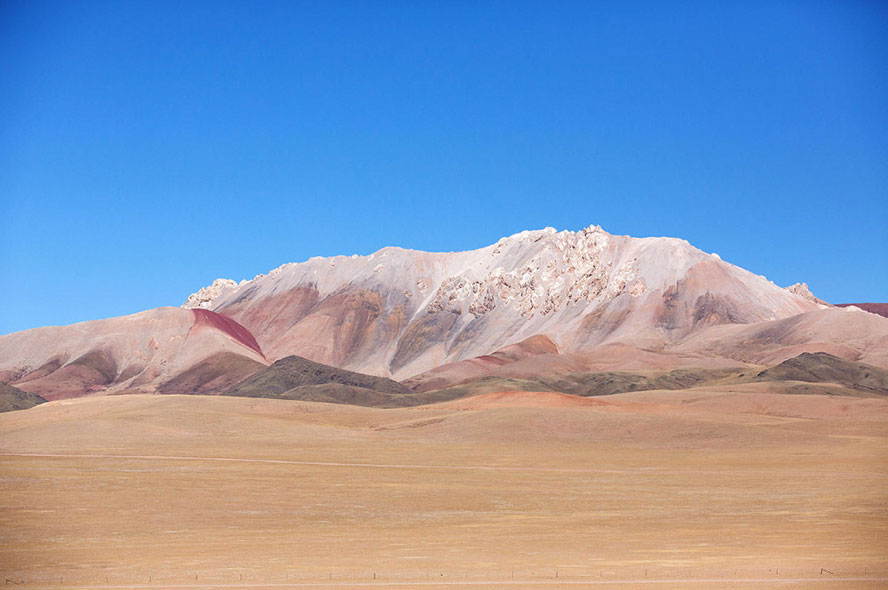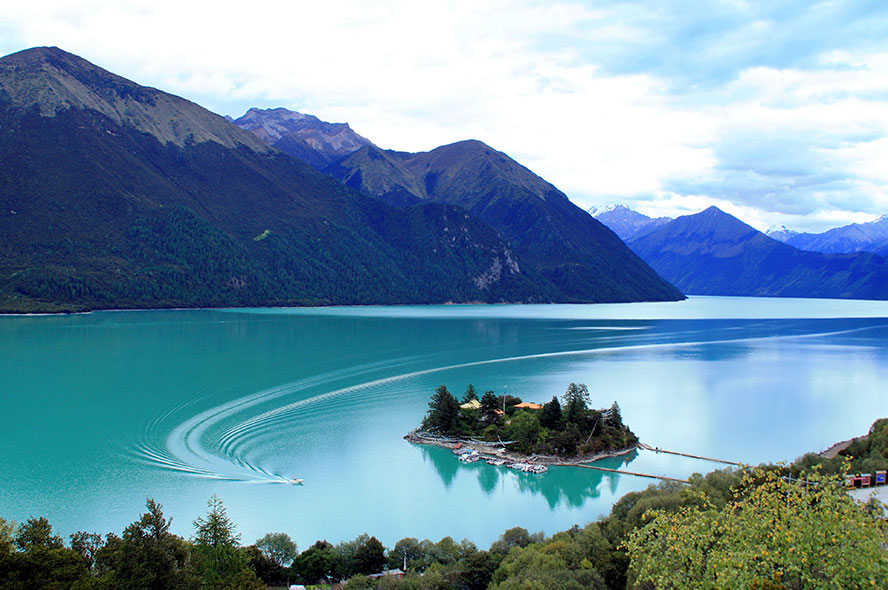March is globally acknowledged to be the end of winter and the beginning of spring. However, that’s not the same in Tibet, as spring does not really start in the region until April. The weather still remains cold in most parts of the place, especially in the western region, where temperatures and weather conditions are just the same as they were in the previous two months, with average temperature ranging from -2 degrees to 12 degrees. In spite of the low temperature, the weather is not humid but dry in the lower-lying areas, as it barely rains during this time of the year.
Thanks to the bright sunshine, even in the two coldest months of the year- January and February, the weather in the daytime in Tibet is warmer than many people think. Besides, the winds in March are not as harsh nor strong as they are in the two cold months. Therefore, a journey to Tibet during this period can be more comfortable and pleasant.
Overall Tibet Climate in March
- Average Lowest Temperature: -2 ℃ (28.4ºF)
- Average Highest Temperature: 12 ℃ (53.6ºF)
- Tibet Average Temperature: 5 ℃ (41ºF)
- Average Precipitation/Rainfall: 8 mm (0.31 in)
- Wet Days (>0.1mm): 1
- Relative Humidity: 72%
Most-Visited Places in Tibet along the Way from Lhasa to Kathmandu via Overland in March
Peak tourist season in Tibet is between April and September. So it isn’t much crowded in Tibet during March. Although most of the region is still cold during the period, weather in the south region such as Nyingchi has already become warmer because of the low altitude, making it one of the first place in Tibet to witness the beginning of spring and one of the most favorable places for travelling during the period. Besides, Lhasa in the southeast and Shanna in the southwest where the weather is warmer than other places in Tibet are also worth a visit in March. Average temperature in Lhasa during this period in the daytime is about 12 to 13 degrees, and around -3 degrees at nights. Tourists just need to wear thermal jackets and sweaters to against the coldness.
Lhasa Tibet Climate in March
- Average Lowest Temperature: -1 ℃ (30.2ºF)
- Average Highest Temperature: 13 ℃ (55.4ºF)
- Average Precipitation/Rainfall: 2 mm (0.07 in)
Lhasa is one of the places in Tibet which enjoys the longest sunlight hours (about 3,000 hours a year, an average of 9 hours per day), that’s why it is called “the city of sunshine”. People who go to Tibet don’t need to worry about the rainfall, as it hardly rains in the daytime even during the rainy season. March is definitely one of the perfect time to visit Lhasa, when the weather is neither too cold nor too hot in the daytime (although it can be chilly at nights), and it is much less crowded than the following months. In the morning, the dews on the building of Potala Palace are shining under the sun, making the palace a more beautiful one. Besides, going to Tibet in March can save visitors a lot of money on train tickets as well as tickets of some tourist attractions.
"Multiple layers" is the dressing principle for a trip to Lhasa in March. We don’t suggest that you wear thick clothes only, because there will be relatively large temperature difference between day and night or even during the daytime. If you wear multiple layers of clothes, you can take off or put on clothes in accordance to the temperature and your own feeling.
In addition, you should slow down your pace while visiting Lhasa. Because Lhasa is located at a high altitude, you might sweat and your heartbeat will accelerate if you walk too fast.
Namtso Tibet Climate in March
- Average Lowest Temperature: -1 ℃ (30.2ºF)
- Average Highest Temperature: 7 ℃ (44.6ºF)
- Average Precipitation/Rainfall: 1 mm (0.04 in)
Namtso Lake, one of the three holy lakes in Tibet ((together with Yamdrok Lake and Lake Masarovar), is of great significance to Tibetans in terms of religious belief. Because of the high altitude of around 4,700 meters, the weather in March is no more different than that of winter. The temperature may be a little higher, but it still remains cold and the lake is frozen. Because there are strong winds during this period, the weather isn’t humid. So March is among the dry season (October to the next April) of the region. Nagenla Pass, from where tourists are able to see the incredible scenery of Namtso Lake, is open to the public in March. Yet the temperature is rather low there, about 3-4 degrees.
Nyingchi Tibet Climate in March
- Average Lowest Temperature: 0 ℃ (32ºF)
- Average Highest Temperature: 13 ℃ (55.4ºF)
- Average Precipitation/Rainfall: 16 mm (0.63 in)
Locate at a lowest altitude of 3,000 meters, Nyingchi is one of the places where spring comes the earliest in Tibet. It is famous for the Peach Blossom Festival held in March. Therefore, March is one of the most populated months in Nyingchi throughout the year, with thousands of tourists from home and abroad coming to celebrate the festival with local Tibetans. Weather during this period in Nyingchi is warm and sunny. Even though it might drizzle in the late evenings, tourists are still able to enjoy their stay in Nyingchi by taking part in all kinds of outdoor activities in the daytime as there is always sunshine during daytime.
Nyingchi Peach Blossom Festival starts in late March
Although spring has come to Nyingchi in March, you still need to bring winter clothes if you plan to go to Nyingchi during this period. The air is humid, and the chance that it rains or snows is still large. Therefore, we suggest that you bring winter clothes such as sweaters, down coats and fleece jackets to Nyingchi in March. And a pair of thermal and anti-skid shoes is necessary as well.
Shannan Tibet Climate in March
- Average Lowest Temperature: -13 ℃ (8ºF)
- Average Highest Temperature: 3 ℃ (37.4ºF)
- Average Precipitation/Rainfall: 3 mm (0.12 in)
Shannan, or “Lhokha” in Tibetan language, refers to the valley regions in the south of Tibet. Compared with other southern regions, weather in Shanna in March is a little bit warmer, with temperature rising up to 3 degrees in the daytime. Because of its topography, temperature at nights might drop dramatically to -13 degrees. Therefore, beauty of the tourist attractions in the region cannot be explored thoroughly during this period. One of the best places to visit in Shannan in March should definitely include Tsedang, the center for politics, economy, and culture of Shannan. Its agriculture industry is the most developed in Tibet, therefore, it is called “the granary of Tibet”. The first arable land is in the north of Tsedang. It is said that in the beginning of sowing seasons, farmers in Tsedang will grab a handful of dirt from the land and then scatter it on their own lands for good harvests of the year. While travelling in Tsedang, tourists can have a taste of the local glutinous rice cake and butter tea, barley wine.
Samye Monastery in Tsedang
The best clothing choice for a trip to Shannan in spring would be the followings:thick pants or trousers + thick sweater + thick coat. Sport shoes are the best for a trip to all the places in Tibet, because the roads in Tibet are pretty rough.
Yamdrok Lake Tibet Climate in March
- Average Lowest Temperature: -6 ℃ (21.2ºF)
- Average Highest Temperature: 4 ℃ (39.2ºF
- Average Precipitation/Rainfall: 1 mm (0.04 in)
Located at an altitude of 4,441 meters, Yamdrok Lake is known as one of the three holy lake in Tibet. Water of the lake begins to freeze in December. As the weather gets warmer in March, the turquoise water begins to melt and birds which migrate to other places during winter fly back again. Therefore, it is also a perfect time to have a look at the birds on the islands around. There are 5 major island for bird-watching, among which the Bird Island is the largest one, which is an ideal habituating place for both local and migrant birds. Lucky enough, tourists may encounter other animals such as mountain sheep, foxes, and Himalayana marmota while visiting Yamdrok Lake during the period.
When there is sunshine in the daytime, you can just wear a sweater plus a fleece jacket in Yamdrok. You need to put on extra thermal underwear inside to keep out the cold when there is no sunshine. In addition, although Yamdrok is getting warm in March, the temperature difference between day and night can still be low. Therefore, you must pay attention to the temperature changes and keep your feet warm at this time.
Join-in the Most Classic Tibet Yamdrok Lake Tour
Gyantse Tibet Climate in March
- Average Lowest Temperature: -6 ℃ (21.2ºF)
- Average Highest Temperature: 8 ℃ (46.4ºF)
- Average Precipitation/Rainfall: 1 mm (0.04 in)
Gyantse is one of the famous historical and cultural county in Tibet as well as an emerging tourist county in China, boasting tourist attractions such as the Palcho monastery and Pala Manor. The county is not far away from Yamdrok Lake and shares similar weather patterns with it. Located at an average altitude of 4,000 meters, the temperature in March remains relatively low (average temperature is around -4 to 2 degrees) and spring doesn’t come to the county until April.
Thermal underwear and sweaters are necessary for a trip to Gyantse in March. Your coats must be wind-proof, as the wind is still strong during this period. Other equipment such as sunglasses, hats and scarves should also be brought with you all the time during the journey.
Shigatse Tibet Climate in March
- Average Lowest Temperature: -5 ℃ (23ºF)
- Average Highest Temperature: 8 ℃ (46.4ºF)
- Average Precipitation/Rainfall: 2 mm (0.08 in)
Shigatse is a city located in the southwest of Tibet, covering an area of 184,000 square kilometers and stretching 800 kilometers from east to west and 220 kilometers from north to south. The weather in the March is nothing different from that of winter — cold and windy. Therefore, thermal clothes are needed for a trip to Shigatse in March. Shigatse in March is less crowded than Nyingchi, whose Peach Blossom Festival has attracted countless people from home and abroad during this period. However, Shigatse is still worth a visit in March. It is a wonderful place for art and history lovers. The Tashilhunpo Monastery in Shigatse treasures murals and sculptures of high artistic value. Besides,Shigatse is also a good transfer city for visitors who want to go to EBC.
As Shigatse is still cold in March, winter clothes such as thick coat is needed for a trip to Shigatse during this period. Besides, thermal underwear and sweaters are also necessary to keep you warm. The coat you wear must be wind-proof. Other equipment you need to prepare for a trip to Shigatse during this period includes: sunglasses (to protect your eyes from the sunshine), hats and scarves (to keep your head and neck warm).
EBC Tibet Climate in March
- Average Lowest Temperature: -12 ℃ (10.4ºF)
- Average Highest Temperature: 7 ℃ (44.6ºF)
- Average Precipitation/Rainfall: 1 mm (0.04 in)
Because of its high altitude of 5,200 meters, it is still cold in BEC in March, with average temperature ranging from -12 to 7 Centigrade degrees. So a long stay in the region is impossible during this period. The good news is that temperature differences between day and night are narrowing in March. The weather is mostly cloudy, with frequent rainfall in the daytime. Therefore, in additions to thermal clothes, water-proof clothes are also required while visiting EBC. More information about EBC tour in Tibet.
You may probably stay in one place in EBC to see the Mt. Everest quietly and you won’t move or walk a lot, so it is important to keep your feet warm during this period. If you have the plan to see the sunrise and sunset there, you need to make a full preparation to against the wind, low temperature and strong sunshine there. While enjoying the sunrise or sunset, do remember to put on a hat and scar and button up your clothes tightly, so that you can stay outdoor for about half an hour when the temperature is minus 10 degrees. Or else you might not be able to bear the coldness and retreat before you could see the sunrise or sunset.
Mt. Kailash Tibet Climate in March
- Average Lowest Temperature: -8 ℃ (17.6ºF)
- Average Highest Temperature: 5 ℃ (41ºF)
- Average Precipitation/Rainfall: 4 mm (0.16 in)
Mt. Kailash is a 6,638 meter-high peak as well as a major pilgrimage site for some Buddhist traditions. There isn’t any sign which marks the coming of spring in the region in March. Temperature during this period is between -8 degrees and 5 degrees. For those who want to go trekking in March, Mt. Kailash is not a good choice, as both the road and pass to the mountain are still covered with snow.
If you still want to go to Mt. Kailash during this period, you should bring thick and thermal clothes such as down coats, cotton coats, wind-proof jackets and thermal under to against the cold during this period. As for shoes, mountaineering boots would be better.
Lhasa to Kathmandu via Overland in March
- Kathmandu Average Lowest Temperature: 8 ℃ (46.4ºF)
- Kathmandu Average Highest Temperature: 24 ℃ (75.2ºF)
- Kathmandu Average Precipitation/Rainfall: 34 mm (1.34 in)
- Gyirong Port Average Lowest Temperature: -1 ℃ (30.2ºF)
- Gyirong Port Average Highest Temperature: 7 ℃ (44.6ºF)
Even though it is still cold in most Tibetan places in March, the highway between Lhasa and Kathmandu has already witnessed thousands of tourists driving between the two cities. The Sino-Nepalese Highway, or the Friendship Highway, is the most unique and fancy road in the world. People who drive along the road are able to see at least 5 peaks which have a height of over 8,000 meters. What’s more, they can also enjoy the most beautiful scenery in Tibet, including snow-covered mountains, vast grassland, as well as multiple incredible lakes. While driving along the highway in March, the most common scenery tourists can see would be patches of snow and dry desert-like landscapes. However, once they reach the Gyirong Valley, the following scenery will be totally different. The weather in Gyirong during this period has already become warmer, with daily temperature being as high as 7 degrees, so verdant foliage and lush meadows are dominating landscapes in the rest part of the route. After crossing the the border, they will, once again, get a totally different scenery in Nepal.
Taking 7 to 8 days’ driving, the road trip from Lhasa to Kathmandu (and vice versa) is believed to be one of the most attractive and surprising adventures while travelling on the plateau. Major route from Lhasa to Kathmandu is called “the west line” (Lhasa - Gyantse - Shigatse - Lazi - G219 - Gyirong Port - Nepal). While driving along the way, tourists can make a short visit to the Rongbuk Monastery, the highest Tibetan Buddhist monastery in the world. Due to the 2015 Nepal earthquake, Zhangmu Port is now only available for freights. So the east line (Lhasa - Shigaze - Lazi-Dingri - Nyalamu County - Zhangmu Port - Friendship Bridge-Kathmandu) will not be chosen in a short term.
Gyirong Port is the last stop in China on the journey from Lhasa to Kathmandu. Tourists need to go through exit formalities before crossing the Resuo Bridge. Once getting into Nepal, tourists have to apply for their visas in the authority agency of the country. After that, they may begin their trip in Nepal by enjoying the lush and spectacular valleys and forests along the way from the border to Kathmandu. Tourists can get transfer service from Gyirong Port to Kathmandu offered by our company, and the fee is 60 USD/person.
Tips: For visitors who want to travel from Kathmandu to Lhasa via overland, they will have to apply for both the Tibet Permit and China Group Visa in Kathmandu. With the help of our staff, visitors can get their documents done quickly. One thing to remember is that visitors have to apply for the visa at the Chinese Embassy in Kathmandu at least 3 days before their tour starts, as it will take 3 working days to finish the process. If possible, tourists are suggested to arrive to Kathmandu 5 days in advance to the day leaving for Tibet. So that they can have enough time to deal with their documents. After handing in the passports, out travel consultants will help you get all the details done.
Tibetan Festivals in March
Most of the festivals in Tibet are religious-related. Different from them, Nyingchi Peach Blossom Festival is held not because of religions, but because of local characteristics. Its opening date is not fixed, depending on the blooming season in the year. But it usually lasts for about a month from mid-March to mid-April, when the weather is neither too hot nor too cold. It is held to attract more travelers to enjoy the beauty of the peach blossoms and explore the unique culture of Nyingchi, and thus further stimulate economy of the prefecture. When tourists go to Nyingchi during this period, they will find they are embraced by stunning pink and violet peach blossoms. Tourists can enjoy the peach blossoms, experience the horsemanship and have a taste of local cuisines during the festival. The best places to enjoy the greatest peach blossom views in Nyingchi include: Gala Village, Yarlung Zangbu Grand Canyon, Nyang River, and Bome County. Tourists can also see beautiful blossoms while driving along the 3187 National Road and the road from Mainlin Airport to Bayi Town.
Because Tibetan festivals are fixed in accordance to Tibetan lunar calendar, two religious festivals may take place in March. One is the Butter Lamp Festival, which is called “Chunga Choepa” in Tibetan language. The other is the Great Prayer Festival, the most important and the greatest religious festival in Tibet. Both of the two festivals were firstly held in 1409 by Tsong Khapa, the founder of the Dalai Lama. The Butter Lamp Festival falls on the 15th day of the first Tibetan lunar month. When the festival comes, giant butter lamps of different symbols and figures with lucky connotations will be displayed on Barkhor Street, making the street a miraculous and beautiful world. People will keep singing and dancing the whole night to celebrate the festival. The Great Prayer Festival is between the 3rd day - 25th day of the first Tibetan lunar month. During the festival, lamas from the three largest monasteries (Drepung Monastery, Sera Monastery, and Gandain Monastery) will gather in the Jokhang Temple to recite scriptures and attend an examination for the Gexi degree, which is a relatively high degree in Tibetan Buddhism system. Only 16 monks are able to get the Gexi degree each year, so the competition is rather fierce. At the same time, pilgrims coming from different places of Tibet will offer donations to the monks.
Sera Monastery Monks' Debate
Recommended Packages for a Tibet Tour in March
The most significant things that must not be forgotten before you get to Tibet include documents such as passport, Tibet Travel Permit as well as Chinese Visa. Besides, as the weather in March is still cold in most of the places in Tibet, clothes of multiple layers and down jackets that can keep you from coldness are of great significance. Others thermal things like gloves, warm shoes, and hats are also necessary for a trip to Tibet in March. Even though the weather in places such as Nyingchi and Chamdo are more moderate, you still need to carry some sweaters in that the temperature may drop dramatically at nights. Besides, snow and ice on the roads in some places might begin to melt during this period, so anti-skid boots of good quality are also of great essential. What’s more, if you don’t want to get a great tan during the trip in Tibet, do bring sunglasses and sun protection equipment such as sun hats and high SPF sunscreen, as there is intense sunlight during the daytime all year round in Tibet. Besides, skin cream, hand cream and lip balm are also necessary to against the dry weather there.
Finally, Oxygen content during this period on the plateau is lower than in summer. Therefore, it is more likely that people will get altitude sickness when they arrive in Tibet in March. You had better take Rhodiola 7 to 15 days in advance before you get to Tibet in case you should get altitude sickness. Medicine like Rhodiola Compound Capsule and Gaoyuan’an that can relieve the symptoms of altitude sickness should also be prepared.
Set Off Now
Tibet remained closed in March in the previous years but now it has open to the public again during the period, giving travelers more chances to appreciate its beauty. Being the closest spot to heaven, Tibet is a place that you should pay a visit at least once in your life. If you don’t go to Tibet and visit the Yamdrok Lake, you won’t know that the pure blue water of the lake will be flicking in various hues under the sunshine. If you don’t go to Tibet and have a far-view of Mt. Everest, you won’t realize how small and tiny people really are in the infinite universe. If you don’t go to Tibet and see the holy snowfields, you won’t believe such pure lands do exist in the world.
Early March is one of the greatest periods throughout the year to enjoy the beauty of Tibet, especially the beauty of Tsedang and along the Friendship Highway from Lhasa to Gyirong Port. This is a time for new growth of grass and the blooming of buds. With the temperature getting higher and the weather getting warmer, tourists are able to enjoy a lot during their stay in Tibet in the period. Besides, as March is the off season in Tiber tourism, travelers can also save a lot money on train tickets, accommodation, and tickets of tourist attractions. To summarize, March is a perfect time for a tour to Tibet.
















































 Data in submission...
Data in submission...